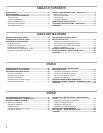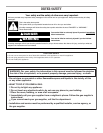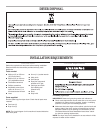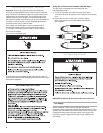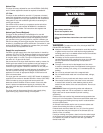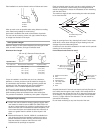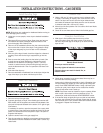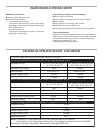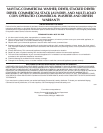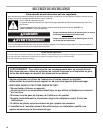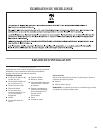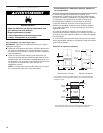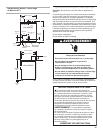
7
Natural Gas:
This dryer is factory adjusted for use with NATURAL GAS (G20),
and no further adjustment should be required at installation.
L.P. Gas:
This dryer is also certified for use with L.P. (propane or butane)
gases with appropriate conversion. No attempt shall be made to
convert the appliance from the gas specified on the model/serial
rating plate for use with a different gas without consulting the
serving gas supplier.
Conversion must be done by a competent service technician.
Gas conversion kit, part number W10233219, is available for
purchase from your dealer. Full instructions are supplied with
the kit.
Natural gas (France/Belgium):
This dryer is also certified for France/Belgium for use with
G20/G25 gases (20 mbar/25 mbar) with appropriate conversion.
No attempt should be made to convert this appliance from the
gas specified on the gas rating label for use with a different gas
without consulting the serving gas supplier. Gas conversion must
be done by a qualified gas service technician. Conversion kit, part
number (W10181947) is available for purchase from your dealer.
Full instructions are supplied with the kit.
Supply line requirements:
Provide a rigid gas supply line to the dryer location. It should be
minimum 12.5 mm (1/2") ID. When acceptable to the gas supplier
and local codes, 10 mm (3/8") ID rigid supply line may be used
for lengths under 6.1 m (20’). Pipe-joint compounds resistant to
the action of L.P. gas must be used.
Gas connection to the dryer itself should be made by means of a
flexible gas hose suitable for the appliance and gas category in
accordance with national installation regulations. If in doubt,
contact the gas supplier. It should be minimum 10 mm (3/8") ID.
A means of restraint should be used between the appliance and
the wall to prevent straining of the rigid gas supply when the
appliance is moved. An appropriate length of chain and a wall
hook is recommended.
The dryer gas inlet connection is a 3/8" NPT thread. An adapter is
supplied for conversion to standard ISO.228-1 thread (3/8" BSP).
Check for leaks by using an approved noncorrosive leak-
detection solution. Bubbles will show a leak. Correct any leak
found. A pressure measurement tapping is provided on the
gas valve within the dryer, accessible after removal of the lower
front panel.
The dryer must be disconnected from the gas supply piping
system during any pressure testing of that system.
WARNING
Fire Hazard
Use a heavy metal vent.
D
o not use a plastic vent.
Do not use a metal foil vent.
Failure to follow these instructions can result in death
or fire.
Venting Requirements
WARNING: To reduce the risk of fire, this dryer MUST BE
EXHAUSTED OUTDOORS.
■ Adequate ventilation has to be provided to avoid the backflow
of gases into the room from other fuel-burning appliances,
including open fires (i.e. available airflow into the room should
match airflow out from the room).
■ The design of the flue system should be such that any
condensate formed when operating the dryer from cold shall
either be retained and subsequently re-evaporated or
discharged.
■ The dryer vent must not be discharged into a flue which
is used for exhausting fumes from appliances burning gas or
other fuels, chimney, wall, ceiling, or a concealed space of a
building.
■ Do not use an exhaust hood with a magnetic latch.
■ Do not install flexible metal vent in enclosed walls, ceilings,
or floors.
■ 102 mm (4") heavy metal vent and clamps must be used.
■ Use clamps to seal all joints. Vent must not be connected
or secured with screws or other fastening devices which
extend into the interior of the vent and catch lint. Do not use
duct tape.
IMPORTANT: Observe all governing codes and ordinances.
Use a heavy metal vent. Do not use plastic or metal foil vent.
Rigid metal vent is recommended to prevent crushing
and kinking.
Flexible metal vent must be fully extended and supported when
the dryer is in its final position. Remove excess flexible metal vent
to avoid sagging and kinking that may result in reduced airflow
and poor performance.
An exhaust hood should cap the vent to prevent rodents and
insects from entering the home or business.
Exhaust hood must be at least 30.5 cm (12") from the ground
or any object that may be in the path of the exhaust (such as
flowers, rocks, or bushes).
If using an existing vent system, clean lint from the entire length
of the system and make sure exhaust hood is not plugged with
lint. Replace any plastic or metal foil vent with rigid metal or
flexible metal vent.




